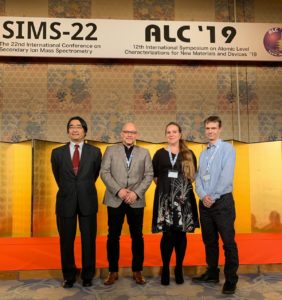EPSRC have funded a new MALDI imaging instrument through their strategic equipment call. The grant, worth £810 k will allow investment in the latest MALDI-ToF technology, enabling us to establish a facility serving internal and external users. The instrument complements the University’s world-leading mass spctrometry imaging capabilities including ToF-SIMS, Nano-SIMS, DESI-MS and LAESI-MS. The Facility will be managed through the Michael Barber Centre for Collaborative Mass Spectrometry.
Congratulations Dr Aldossari!
Congratulations to Samar on the award of her PhD. Her thesis entitled ‘Detection and localisation of drug molecules in biological samples using secondary ion mass spectrometry (SIMS)’ was co-supervised by Dr Katie Moore and employed both ToF-SIMS and NanoSIMS.

New ToF-SIMS instrument delivered
Nick elected to the SIMS International Committee
SIMS 22: Kyoto, Japan
Welcome Matija
We welcome a new PhD student, Matija Lagator from Serbia. Matija will work on the new J105-SIMS instrument. His project is entitled ‘Development of Novel High Energy Cluster Ion Beam Methodology for Molecular Analysis and Imaging’.
New Funding for Battery Characterisation
UKRI/The Faraday Institution have funded a project led by Dr Robert Weatherup (Diamond Manchester Research Fellow)
“What lies beneath? – new multimodal platforms for operando characterisation of buried interfaces in working batteries.”
The principal goal of this proposal is to develop new in-situ and operando platforms including ToF-SIMS, NAPXPS and HAXPES that will enable characterisation of buried interfaces in working batteries.
New funding for plant cell SIMS
A BBSRC Flexible Talent Mobility Award to Dr Jolanda van Munster (School of Chemistry & MIB) and Dr Sadia Sheraz (School of Materials) will allow us to extend our SIMS research into plant matter. The project entitled “Correlative mass-spectrometry imaging for nanoscale structural insight into plant biomass for food and biotechnology” is in collaboration with Dr Katie Moore (School of Materials), Prof Richard Ward (University of São Paulo-Ribeirão Preto, Brazil) and Rothamsted Research Ltd.
Congratulations Professor Lockyer!
 The School of Chemistry at the University of Manchester have awarded Nick Lockyer a Chair in Physical Chemistry.
The School of Chemistry at the University of Manchester have awarded Nick Lockyer a Chair in Physical Chemistry.
Nick came to the University (then UMIST) to read Chemistry in the late 1980s and continued to study for a PhD in Laser Ionisation Mass Spectrometry of Biomolecules, awarded in 1996. His postdoctoral research involved the development of the Biotof, an imaging ToF-SIMS instrument, with a focus on laser post-ionisation, sputtered neutral mass spectrometry (SNMS).
He was awarded a Leverhulme Special Research Fellowship to further develop the Biotof as a Chemical Microscope, following which he was appointed lecturer in Chemistry. Nick briefly moved to the School of Chemical Engineering and Analytical Science (CEAS), during the merger of UoM and UMIST in 2004, before moving back to Chemistry in 2011. With his research group in the Manchester Institute of Biotechnology (MIB), and also the Photon Science Institute (PSI), he has explored a range of imaging mass spectral modalities in the area of biology and biomaterials, together with technique and instrument development.
As the result of successful bids to EPSRC and the Royce Institute he was awarded a major grant to replace the Ionoptika J105 3D Chemical Imager with a new instrument. This will involve consolidating the research group in the PSI providing opportunities to further explore advanced materials and photonic approaches to mass spectrometry.
New project funded
| New Developments in Quantitative 3D Chemical Imaging
A major new EPSRC grant of £844k will allow us to explore further the 3D imaging SIMS capabilities of reactive cluster projectile using a new high-energy ion beam. Project partners include Prof Ian Gilmore at the National Physical Laboratory and Prof Arnaud Delcorte at the Universite catholique de Louvain. The funding, togther with investment from the Henry Royce Institute allows us to replace our prototype Ionoptika J105 SIMS with the latest model, including a 70 keV water cluster beam. This comes 10 y after the installation of the first J105 instrument in Manchester. |
New Collaboration in Biofuel Biotechnology
Funding from the Sao Paulo Research Foundation “FAPESP” and the University of Manchester for a new collaboration with Dr Jolanda van Munster, BBSRC research fellow in the Manchester Institute of Biotechnology (MIB) and Prof. Richard John Ward, group leader of the Protein Biochemistry and Biophysics Laboratory, University of São Paulo-Ribeirão Preto.
The aim is to bring together expertise in protein engineering and polysaccharide mass spectrometry to enhance understanding of cell wall architecture at the micrometer scale to guide enzymatic deconstruction of lignocellulose for enhanced biofuel production.
Dr Huriyyah Alturaifi
Congratulations to Huriyyah on the award of her PhD! Her thesis is entitled ‘New Capabilities for Molecular Surface and in-depth Analysis with Cluster Secondary Ion Mass Spectrometry’. The project was co-supervised by Prof Mike Turner at the Organic Materials Innovation Centre.
Dr Szula!
Congratulations to Ewa on being awarded her PhD!
A just reward for all her hard work. Well done!
Dr Giles Edwards
Congratulations to Giles on the award of his PhD entitled ‘Advances in Bioanalytical Laser Ionisation Mass Spectrometry’.
Dr Afnan Alnajeebi
Congratulations to Afnan on the award of her PhD entitled ‘Comparison of cluster primary ion beams for quantitative biomolecular SIMS analysis’.




